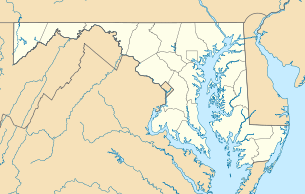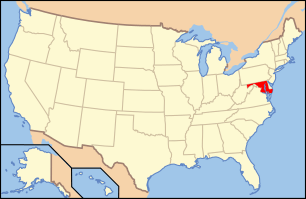Pigtown, Baltimore
|
Pigtown Historic District (aka "Washington Village") | |
|
| |
|
Pigtown Historic District, December 2011 | |
 | |
| Location | Roughly bounded by McHenry, Ramsay, West Barre, South Paca, West Ostend, Wicomico, Bush and Bayard Streets, plus B&O Railroad (CSX/Amtrak), Baltimore, Maryland |
|---|---|
| Coordinates | 39°16′49″N 76°37′56″W / 39.28028°N 76.63222°WCoordinates: 39°16′49″N 76°37′56″W / 39.28028°N 76.63222°W |
| Area | 50 acres (20 ha), .325 sq mi[1] |
| Architectural style | Federal, Greek Revival, Italianate |
| Governing body | Local |
| NRHP Reference # | 06001177[2] |
| Added to NRHP | December 28, 2006 |
"Pigtown", also known as "Washington Village", is a neighborhood in the Southwest District of Baltimore, bordered by Martin Luther King Jr. Boulevard (with the University of Maryland, Baltimore campus, Downtown Baltimore and the "Inner Harbor") to the east, Monroe Street on the west, Russell Street/Baltimore-Washington Parkway (Interstate 295) on the south, and the B&O Railroad Museum at the Mount Clare Shops on West Pratt Street on the north.[1][3] The neighborhood acquired its name during the second half of the 19th century, when pigs arriving from the Midwest on the B&O Railroad were herded across Ostend and Cross Streets to the butcher shops and meat packing plants located in the neighborhood.[4]
Pigtown is known for its annual Pigtown Festival.[5]
Pigtown's proximity to the I-95 corridor, the University of Maryland Medical Center, Gerald Field, Oriole Park at Camden Yards, M & T Bank/Ravens Stadium, and Downtown Baltimore has attracted developments of upscale townhouses to the eastern edge of the neighborhood, jumping west in 2012 across Martin Luther King Junior Boulevard to include the eclectic, historical preservation and renovations of Barre Circle. Other parts of the neighborhood have remained "working class", with the older version of townhomes known as rowhouses, often with 1950s-era formstone facades on brick fronts. Pigtown is one of a few residential communities in Baltimore that are completely mixed racially, culturally and economically. There are 2,740 homes in the area, which continues to enjoy an influx of population. In the decade from 1980 to 1990 the population increased by 3 percent, from 6,503 to 6,705 people, contributing to Pigtown's racial and socio-economic diversity.
History
The area where Pigtown is now located was originally part the Mount Clare plantation, a 2,368 acre estate owned by Dr. Charles Carroll in the 18th century. Carroll built one of Maryland's first iron foundries on the property, which operated the largest pig iron furnace in the colonies prior to the American Revolution. Dr. Carroll was a cousin of Charles Carroll of Carrollton, who signed the Declaration of Independence.[6][7]
In 1827, the Baltimore & Ohio Railroad was founded in Baltimore. Ground was broken on the Mount Clare property in 1828, with the first stone laid by Charles Carroll of Carrollton, at the age of 90. Initially providing service between Baltimore and Ellicott Mills (now Ellicott City, Maryland), the railroad began operating along West Pratt Street on May 22, 1830. The horsedrawn cars of the early B&O Railroad were the nation's first regular passenger rail.[8][7]
Construction of the first houses to the north and south of the railroad yards began in 1833. A community of railroad workers grew along Columbia Avenue (now Washington Boulevard) in the 1840s, followed by industrial development in the 1850s and 1860s. Slaughter houses located near the railroad yards earned the area its name as Pigtown by herding pigs across the streets from the rail cars.[7]
Although official records have identified the neighborhood as Washington Village at various points since the 1970s, it has been consistently labeled as Pigtown since 2006 at the insistence of community groups such as Southwest Community Council, Inc.[7]
Historic landmarks
Pigtown has several historic landmarks, including some national landmarks. Patrick's of Pratt Street, which has operated at 934 West Pratt Street for more than 160 years, claims to be "America's Oldest Irish Pub".[9] The Bayard Station valve house at 1415 Bayard Street, built in 1885 by the Chesapeake Gas Company to distribute coal gas in Baltimore, now serves as home to Housewerks, an architectural salvage store.[10] Pigtown is also home to the historic B&O Railroad Museum, which houses exhibits of historic significance to American railroading and items specific to the Pigtown community.
Mount Clare Mansion, a brick Georgian plantation house built in 1763, is the oldest remaining Colonial-era structure in Baltimore.[11] It was purchased by the city government in 1890, along with 70 acres of land, for use as a park. Located at 1500 Washington Boulevard, the former home of Dr. Charles Carroll has been maintained as a museum by the Maryland chapter of The National Society of the Colonial Dames of America since 1917.[12]
Culture
The blue collar culture of Pigtown began with the individuals who worked on the B&O Railroad and German immigrants who opened butcher shops in the neighborhood. Community organizations have emphasized the importance of the neighborhood's history and blue collar origin as they rebuffed attempts to rename it Washington Village.[7]
Pigtown celebrates its culture yearly during the Pigtown Festival, which features local food, entertainment and “squeakness”, a race featuring pigs. The pig race pays homage to the neighborhood's beginning with the railroad, railroad workers and German butchers.[5]
Horseshoe pit
Since the 1970s, an empty lot at the corner of Ward and Bayard Streets has served as the community horseshoe pit. Its significance in the community is commemorated by a mural, painted on a building beside the lot, about 15 years after the first horseshoe stakes were planted there. In 2007, the 12-by-60 foot area was sold by the city government to a developer. It was repurchased by the city in 2010, and is now preseverd and maintained as the community horseshoe pit by Baltimore Green Space, a local nonprofit organization. The first Annual Horseshoe Tournament at the Pit In Pigtown was held in 2011.[13][14]
Demographics
Pigtown is bustling with diversity, in terms of land uses and landscape. Pigtown is one of the many stops on the Gwynn Falls trail connecting more than thirty Baltimore neighborhoods. It is home to the historic Carroll Park that consists of baseball fields, football fields, basketball courts, a skate park, and playgrounds for tots. The area also consists of a multitude of warehouses and industrial life. The community is a mix of old and new, seen through the infrastructure of homes and other local business.
Pigtown is the most diverse neighborhood in the city of Baltimore, as well as one of the most significant locations in Baltimore’s history. Pigtown is home to a multitude of races and economical classes that live unsegregated throughout.
In its community statistical area profile for the Pigtown area, the Baltimore Neighborhood Indicators Alliance reported a population of 5,503 residents in the neighborhood, living in approximately 2,740 homes during 2010. These homes consisted of newly built town homes, older row houses, condominiums and apartments, with an average of 2.4 residents per household. By 2012, neighborhood housing was estimated to have increased to 2,760 homes. Its population mix in 2010 was estimated as 49 percent African American, 39 percent white, 5.3 percent Hispanic and 6.7 percent other, giving the area a 61.2 diversity index, well above the 54.5 citywide index. The majority (59.9 percent) of the area's population was reported in the age range of 25 to 64. Median income of $44,993 was estimated for 2010, but 30.5 percent of the area's households were under $25,000 and 25.3 percent were considered below the poverty line. Its poverty rate was significantly greater than the citywide rate of 17.7 percent.[15]
The 50-acre community statistical area measured by the Baltimore Neighborhood Indicator's Alliance is somewhat larger than Pigtown, including the neighborhoods of Carroll Park and Barre Circle.[15]
During 2012, the Pigtown community statistical area experienced an unemployment rate of 12.7 percent, somewhat better than the citywide rate of 13.9 percent for the year.[15]
Transportation
Eastern portions of Pigtown are within walking distance of Camden Station, served by both the Baltimore Light Rail and the MARC Camden Line. The neighborhood's proximity to Camden Station, Interstate-95 and the Baltimore-Washington Parkway, provides residents with access to important regional commuter routes.
Route 36 (MTA Maryland) provides the neighborhood with local bus service along Washington Boulevard, on its daily route between Northern Parkway (north) and Lansdowne (south).[16]
Education
Three elementary schools are located in Pigtown: George Washington Elementary, Charles Carroll Barrister Elementary, and Southwest Baltimore Charter School. There are two middle schools in Pigtown: Mount Claire Christian School and Franklin Middle. No high schools are located in the neighborhood.
In 2011, 8.87 percent of the children in Pigtown were receiving free or reduced price school lunches, and 15 percent were enrolled in special education programs. The racial composition of Pigtown students was 76.6 percent African-American, 17.2 percent white, and 2.1 percent Hispanic. Thirty-two percent of Pigtown's adult residents had a Bachelor's degree or higher in 2011, while another 41 percent had at least a high school diploma, but 26 percent had not completed high school.
Crime rate
The overall crime rate in the Pigtown community statistical area (which includes Carroll Park and Barre Circle), at 121.4 per thousand residents for the year of 2012, was drastically higher than the citywide average 61.8 per thousand. Violent crime in Pigtown was 23.1 per thousand, while the city saw an average of 14.7 per thousand. The city had a property crime rate of just 47 per thousand residents in 2012, but the rate in Pigtown hit 98.3. Juvenile arrests were at a rate of 91.7 per thousand in Pigtown compared to the citywide rate of 79.2 in 2012.[15]
References
- ↑ 1.0 1.1 "Washington Village neighborhood in Baltimore, Maryland". City-Data.com. Retrieved May 13, 2014.
- ↑ "National Register Information System". National Register of Historic Places. National Park Service. 2009-03-13.
- ↑ "Pigtown/Washington Village". Live Baltimore. Retrieved May 1, 2014.
- ↑ "History". Pigtown Main Street. Retrieved May 1, 2014.
- ↑ 5.0 5.1 "Pigtown Festival". Retrieved May 1, 2014.
- ↑ Michael Anft (April 15, 2005). "Washington Village/Pigtown". The Baltimore Sun.
- ↑ 7.0 7.1 7.2 7.3 7.4 "The History of Pigtown's Name" (PDF). Historic Pigtown. Citizens of Pigtown Community Association. September 2007.
- ↑ Harwood, Herbert W., Jr. (1979). Impossible Challenge. Baltimore: Bernard, Roberts and Co. pp. 12–21. ISBN 0-934118-17-5.
- ↑ "Best of Baltimore 2007". Baltimore Magazine. August 2007.
- ↑ "The History of Bayard Station". Housewerks. Retrieved May 5, 2014.
- ↑ "Mount Clare". National Historic Landmark. Retrieved May 5, 2014.
- ↑ "Mount Clare". National Park Service. Retrieved May 5, 2014.
- ↑ Jonathan Pitts (June 25, 2011). "Horseshoe pit helps build Pigtown's neighborhood spirit". The Baltimore Sun.
- ↑ "Pigtown Horseshoe Pit". Baltimore Office of Sustainability. Retrieved May 5, 2014.
- ↑ 15.0 15.1 15.2 15.3 "Vital Signs 12 Community Statistical Area (CSA) Profiles: Washington Village" (PDF). Baltimore Neighborhood Indicators Alliance. Retrieved May 15, 2014.
- ↑ "Route 36 Local Bus Schedule" (PDF). MTA Maryland. February 9, 2014.
External links
- Pigtown Festival
- Pigtown Historic District, Baltimore City, including photo from 2005, at Maryland Historical Trust
- Citizens of Pigtown
| |||||||||||||||||||||||||

